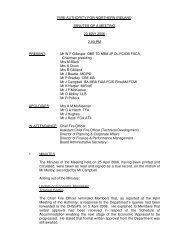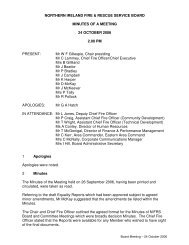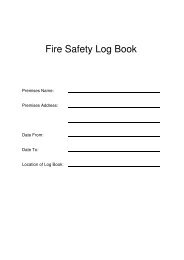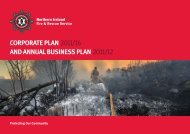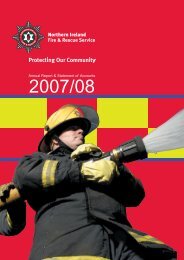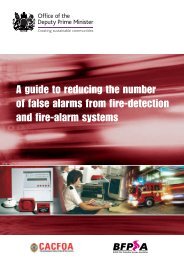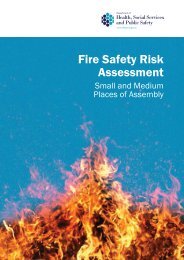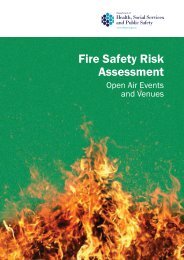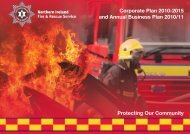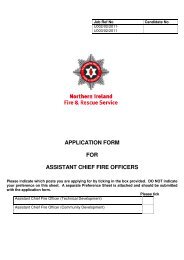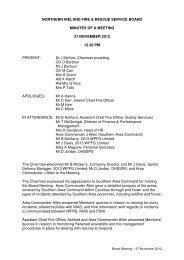DRIVER TRAINING POLICY - Northern Ireland Fire & Rescue Service
DRIVER TRAINING POLICY - Northern Ireland Fire & Rescue Service
DRIVER TRAINING POLICY - Northern Ireland Fire & Rescue Service
You also want an ePaper? Increase the reach of your titles
YUMPU automatically turns print PDFs into web optimized ePapers that Google loves.
<strong>DRIVER</strong> <strong>TRAINING</strong> <strong>POLICY</strong><br />
Date: May 2013<br />
Prepared by:<br />
FRSTC
VERSION CONTROL<br />
VERSION<br />
PREPARED<br />
ACTION<br />
No.<br />
BY<br />
1.0 New Policy AGC White<br />
APPROVED<br />
BY<br />
DATE<br />
ISSUED<br />
Driver Training - Final
<strong>DRIVER</strong> <strong>TRAINING</strong> <strong>POLICY</strong><br />
CONTENTS<br />
1 INTRODUCTION 3<br />
2 AIMS AND SCOPE OF THE <strong>POLICY</strong> 3<br />
3 EQUAL OPPORTUNITIES 3<br />
4 NIFRS <strong>DRIVER</strong>S 3<br />
4.1 The Law 3<br />
4.2 Driver Selection 4<br />
4.3 Driver & Vehicle Categories 4<br />
4.4 Driving Licences 4<br />
4.5 Driver Risk Rating 5<br />
4.6 Driving Assessments/Tests 6<br />
4.7 Occupational Health 7<br />
5 <strong>DRIVER</strong> <strong>TRAINING</strong> PROGRAMMES 7<br />
5.1 Initial Training & Assessment 7<br />
5.2 Large Goods Vehicle (LGV) Driver Training 7<br />
5.3 Emergency <strong>Fire</strong> Appliance Driver (EFAD) Training 8<br />
5.4 Emergency Light Vehicle Driver (ELVD) Training 9<br />
5.5 Specialist Appliances 9<br />
5.6 Refresher Training 9<br />
APPENDICES<br />
Appendix ‘A’ - LGV & EFAD Driver Training<br />
Appendix ‘B’ - EU Vehicle Categories<br />
Appendix ‘C’ - Driver Risk Rating (SC83)<br />
Appendix ‘D’ - NIFRS Driver Instructors, Examiners and Tests<br />
Page<br />
No<br />
2
1 INTRODUCTION<br />
1.1 NIFRS drivers have to operate to the highest professional standards.<br />
Whether responding to emergency incidents or performing routine<br />
driving duties, NIFRS drivers must demonstrate professionalism, care<br />
and consideration at all times and not endanger other road users.<br />
1.2 Driver training contributes directly to improved road safety standards<br />
and is a key component in the overall management of occupational<br />
road risk. NIFRS has a legal responsibility to ensure that anyone<br />
undertaking driving duties in the course of their employment is properly<br />
trained. Individual members of staff also have a legal responsibility to<br />
exercise a duty of care and to adhere to Road Traffic Regulations.<br />
2 AIMS AND SCOPE OF THE <strong>POLICY</strong><br />
2.1 This policy provides the framework within which all driver training will<br />
take place and its principal aim is to ensure that NIFRS drivers are<br />
competent to perform their duties to a high standard<br />
2.2 The policy’s primary objectives are:<br />
• To contribute to a reduction in occupational road risk through the<br />
provision of high quality driver training;<br />
• To set standards for driver training, supervision and assessment<br />
• To establish selection criteria and procedures.<br />
2.3 This policy applies to all NIFRS employees who are required to drive<br />
emergency response vehicles including under emergency conditions.<br />
The policy also applies to any NIFRS employee engaged in providing<br />
driver training or conducting driving assessments/tests.<br />
3 EQUAL OPPORTUNITIES<br />
3.1 The Driver Training Policy applies equally to all operational personnel<br />
and it provides equality of opportunity in the provision, delivery and<br />
assessment of driver training.<br />
4 NIFRS <strong>DRIVER</strong>S<br />
4.1 The Law<br />
4.1.1 All NIFRS drivers are subject to the provisions of the Road<br />
Traffic Regulations (<strong>Northern</strong> <strong>Ireland</strong>) Order 1997 and other<br />
associated legislation. These Regulations provide certain<br />
exemptions when <strong>Fire</strong> <strong>Service</strong> vehicles are being used for<br />
emergency purposes.<br />
3
4.1.2 Under the Management of Health and Safety at Work (NI)<br />
Regulations 2000 and NIFRS Health and Safety Policy on The<br />
Management of Occupational Road Risks, NIFRS drivers<br />
have a duty of care to their work colleagues and to other road<br />
users. This responsibility extends to the Officer-in-Charge of<br />
the vehicle as the person in authority.<br />
4.1.3 NIFRS drivers are also required, by law, to ensure the safety<br />
of their vehicle whilst being driven and for the safe positioning<br />
of vehicles at operational incidents.<br />
4.2 Driver Selection<br />
4.2.1 NIFRS must maintain a sufficient number of suitably trained<br />
and qualified drivers to ensure that it meets service delivery<br />
demands. Driver selection will therefore be made on the basis<br />
of organisational need. This need will be dictated at a local<br />
level.<br />
4.2.2 It is important that personnel who are required or selected to<br />
become NIFRS drivers have the necessary aptitude and<br />
attitude to become safe and skilful drivers.<br />
4.2.3 Further information on the nomination and selection process<br />
for LGV and Emergency <strong>Fire</strong> Appliance Driver training is<br />
contained at Appendix ‘A’.<br />
4.3 Driver & Vehicle Categories<br />
4.3.1 NIFRS personnel will be trained to drive the relevant category<br />
of vehicle under emergency or non-emergency conditions in<br />
order to fulfil their role as a driver.<br />
4.3.2 NIFRS operates a large fleet of vehicles, which includes the<br />
vehicle categories listed at Appendix ‘B’.<br />
4.3.3 When a driver has successfully completed the appropriate<br />
driver training course and obtained the necessary driving<br />
experience, where required, they will only be eligible to drive<br />
the classification of vehicle for which they are qualified.<br />
4.4 Driving Licences<br />
4.4.1 All drivers have a legal responsibility to ensure that they have<br />
a valid driving licence for the category of vehicle that they are<br />
required to drive.<br />
4.4.2 Each driver has a personal responsibility to ensure that their<br />
driving licence is renewed with the Driver & Vehicle Agency<br />
<strong>Northern</strong> <strong>Ireland</strong> (DVA) before the expiry date of the licence is<br />
reached.<br />
4
4.4.3 Personnel required to drive NIFRS vehicles will have their<br />
driving licence renewed by NIFRS. It is the personal<br />
responsibility of each driver to inform his/her line manager<br />
6 months prior to the expiry date of the licence.<br />
4.4.4 It is the responsibility of each driver to ensure that his/her line<br />
manager and DVA are informed of any material changes to<br />
their driving licence, such as a change of address, vehicle<br />
categories, etc.<br />
4.4.5 An NIFRS driver who receives an endorsement on their<br />
driving licence must advise his/her line manager immediately,<br />
in writing, by completing Form SC83 (see Appendix ‘C’).<br />
Failure to do so may result in disciplinary action.<br />
4.4.6 Driving licences will be subject to recording and audit as part<br />
of NIFRS District and Station Audit Programme.<br />
4.5 Driver Risk Rating<br />
4.5.1 NIFRS uses a process of Driver Risk Rating. The purpose of<br />
this process is to enable line managers to identify individual<br />
drivers who may represent a higher risk and to address any<br />
potential training issues.<br />
4.5.2 A driver’s risk rating may be affected if:<br />
(a)<br />
(b)<br />
(c)<br />
(d)<br />
(e)<br />
(f)<br />
(g)<br />
The driver is recently qualified (ie, less than 12 months);<br />
The driver has a history of culpable accidents (ie, 2 in a<br />
rolling 12-month period);<br />
The driver has accumulated more than 6 penalty points<br />
for motoring offences in a rolling 36-month period;<br />
The driver has any unspent convictions for motoring<br />
offences;<br />
The driver has been identified as a higher risk as a result<br />
of a driving assessment;<br />
The driver has a history of driving related Customer<br />
<strong>Service</strong> Standards complaints (ie, 2 in a rolling 24-month<br />
period);<br />
There any adverse observations, comments or<br />
recommendations from his/her line manager.<br />
4.5.3 A driver who has been identified as a ‘high risk’ will be<br />
referred to the <strong>Fire</strong> & <strong>Rescue</strong> Training Centre for an<br />
assessment to determine if refresher training is required. A<br />
driver may also be required to attend for assessment if his/her<br />
line manager has identified a particular training need.<br />
5
4.5.4 Driver risk details are to be recorded on Form SC83 (see<br />
Appendix ‘C’). This Form will be completed by the driver’s line<br />
manager. The driver will have an opportunity to read his/her<br />
line manager’s report and sign it accordingly. On completion,<br />
Form SC83 will be sent to District/Area Command where a<br />
decision will be made, in conjunction with <strong>Fire</strong> & <strong>Rescue</strong><br />
Training Centre, on the type of training necessary to develop<br />
the driver to the required standards. In certain circumstances<br />
this may involve suspension of NIFRS driving duties pending<br />
the outcome of any assessment<br />
4.6 Driving Assessments/Tests<br />
4.6.1 Personnel may be required to undergo a driving assessment<br />
due to their –<br />
• Role requirement;<br />
• Need to undertake a higher level of specialist training;<br />
• Driving and accident history;<br />
• Extended absence from driving or operational duties.<br />
4.6.2 An assessment of driver competence may be conducted<br />
either at the end of a driver training course or as a standalone<br />
assessment. The purpose of a driving assessment is to<br />
confirm that a student possesses the necessary driving skills<br />
and abilities to perform competently. The assessment may<br />
also be used to identify any training needs required to address<br />
weaknesses in a student’s performance.<br />
4.6.3 A driving assessment will normally take place over<br />
approximately 90 minutes but may be extended at the<br />
discretion of the Instructor. Personnel not demonstrating the<br />
required driving competencies may be required to undergo<br />
remedial refresher training, the length and content of which<br />
will be dependent on the circumstances of each case.<br />
4.6.4 In extreme cases, drivers who are deemed to be unsafe on<br />
the road following an assessment will have their authorisation<br />
to drive NIFRS vehicles amended or suspended until further<br />
training has been successfully undertaken. Re-training will be<br />
structured to address the individual’s needs and a full training<br />
course may not always be necessary.<br />
4.6.5 Driving tests may be carried out by the Driver & Vehicle<br />
Testing Agency or by a suitably qualified NIFRS Driving<br />
Examiner. Further information on NIFRS procedures<br />
regarding Driving Examiners and tests is contained at<br />
Appendix ‘D’.<br />
6
4.7 Occupational Health<br />
4.7.1 Personnel will undergo a medical health check when applying<br />
for an LGV licence for the first time. Additionally, a driver over<br />
45 years old will also require a Doctor’s report when renewing<br />
their LGV licence.<br />
4.7.2 It is the personal responsibility of each driver to notify his/her<br />
line manager and DVA immediately of any serious illness or<br />
disability that is likely to last more than 3 months.<br />
5 <strong>DRIVER</strong> <strong>TRAINING</strong> PROGRAMME<br />
5.1 Initial Training & Assessment<br />
5.1.1 The aim of driver training is to raise the standard of a<br />
student’s driving to a high level and to provide each student<br />
with the necessary knowledge, skills and confidence to drive<br />
under differing road, weather and traffic conditions. Driver<br />
training may be undertaken as part of an initial training course<br />
or as part of subsequent refresher training.<br />
5.1.2 An NIFRS driver will only be able to drive NIFRS vehicles<br />
when they have successfully completed all the necessary<br />
training and have been assessed by a suitably qualified<br />
Examiner/Assessor.<br />
5.2 Large Goods Vehicle (LGV) Driver Training<br />
5.2.1 In order to be eligible to drive a NIFRS Large Goods Vehicle<br />
(LGV) Class C (rigid chassis) or LGV Class C+E (articulated<br />
chassis) personnel must be in possession of a valid licence<br />
for the class of vehicle they are required to drive.<br />
5.2.2 The LGV qualification does not confer entitlement to drive a<br />
fire appliance under emergency conditions or operate a<br />
specialist appliance (eg, turntable ladder, hydraulic platform,<br />
multi-purpose vehicles, etc) for which additional training is<br />
required.<br />
5.2.3 Personnel nominated to undertake the LGV Driver Training<br />
Course must hold a DVA provisional driving licence applicable<br />
to the class of vehicle, and must have successfully completed<br />
the required Theory and Hazard Perception Test.<br />
5.2.4 Driver training will be carried out by a qualified NIFRS Driving<br />
Instructor. Students will be required to produce both sections<br />
of their driving licence and a successful Theory Test<br />
Certificate prior to commencing the LGV Training Course.<br />
7
5.2.5 The duration of the Course will normally be for a period of<br />
5 days, the 5th day to include the Driving Test, based on the<br />
individual’s needs. Where a student has reached the required<br />
standard prior to the 5 th day, they may be nominated to<br />
undertake the test in a shorter timeframe.<br />
5.2.6 On successful completion of the Driving Test, the Examiner<br />
will be responsible for ensuring that the student’s driving<br />
licence and relevant documentation is forwarded to DVA for<br />
updating.<br />
5.2.7 Upon receipt of the updated driving licence, individuals will be<br />
permitted to undertake non-emergency driving duties in an<br />
operational appliance whilst accompanied by a qualified<br />
Emergency <strong>Fire</strong> Appliance Driver who will take over the<br />
appliance in the event of an emergency call.<br />
5.2.8 The LGV course is a precursor to attending the Emergency<br />
<strong>Fire</strong> Appliance Driver (EFAD) Course. This Course must be<br />
successfully completed before a driver can drive an appliance<br />
under emergency conditions. Further information on the<br />
nomination and selection of emergency appliance drivers is<br />
provided in Appendix ‘A’.<br />
5.3 Emergency <strong>Fire</strong> Appliance Driver (EFAD) Training<br />
5.3.1 Personnel progressing to undertake the Emergency <strong>Fire</strong><br />
Appliance Driver (EFAD) Training Course must hold a full<br />
DVA driving licence and provide evidence that they have<br />
completed 8 hours familiarisation driving.<br />
5.3.2 Driver training will be carried out by a qualified NIFRS Driving<br />
Instructor and students will be required to produce both<br />
sections of their driving licence.<br />
5.3.3 Where a NIFRS Driving Instructor identifies that a driver is not<br />
performing to the required EFAD standards, subsequent<br />
training will be made available to develop the driver.<br />
5.3.4 Emergency <strong>Fire</strong> Appliance Drivers will be required to<br />
undertake a one day refresher course at periods not<br />
exceeding 5 years.<br />
8
5.4 Emergency Light Vehicle Driver (ELVD) Training<br />
5.4.1 Personnel undergoing the ELVD Training Course must hold a<br />
full DVA driving licence applicable to the class of vehicle.<br />
5.4.2 The ELVD qualification will be gained by attending the 5 day<br />
training course which will be carried out by a qualified NIFRS<br />
Approved Driving Instructor.<br />
5.4.3 Emergency Light Vehicle Drivers will be required to undertake<br />
a one day refresher course at periods not exceeding 5 years.<br />
5.5 Specialist Appliances<br />
5.5.1 A specialist appliance is defined as an appliance that requires<br />
specialised driving skills and also knowledge of the appliance<br />
and its role within the organisation. Classification typically<br />
includes –<br />
• Aerial Appliances;<br />
• <strong>Rescue</strong> Pumps;<br />
• Water Carriers<br />
• De-mountable Vehicles;<br />
• Command Support Units;<br />
• 4x4 Off Road Vehicles.<br />
5.5.2 NIFRS personnel who are required to drive a specialist<br />
appliance under emergency conditions must:<br />
• Be in possession of valid driving licence for that class of<br />
vehicle;<br />
• Be a qualified Emergency <strong>Fire</strong> Appliance Driver;<br />
• Have completed training, including under emergency<br />
conditions, specific to the vehicle type;<br />
• Have familiarised themselves with any specific/unique<br />
features of the vehicle.<br />
5.5.3 Specialist drivers will be required to undertake a one day<br />
refresher course at periods not exceeding 5 years.<br />
5.6 Refresher Training<br />
5.6.1 Under guidance from the relevant National Occupational<br />
Standards, NIFRS drivers will carry out refresher training<br />
periodically, normally within periods not exceeding 5 years.<br />
Training needs may be assessed at any time to ascertain the<br />
appropriate level of instruction required.<br />
9
5.6.2 Refresher training will normally include technical updates, new<br />
driving procedures, amended NIFRS policy, maintenance of<br />
skills and knowledge levels, etc.<br />
5.6.3 A member of staff who has been absent from their normal<br />
duties and has not driven an emergency response vehicle or<br />
operated a specialist appliance for a period exceeding<br />
6 months will be required to undergo refresher training.<br />
10
Appendix ‘A’<br />
LGV & EFAD <strong>DRIVER</strong> <strong>TRAINING</strong><br />
Shortfall identified in<br />
Watch/Station driver levels<br />
or self-nomination<br />
Request submitted for<br />
LGV Course<br />
Refresher training<br />
every 5 years or<br />
otherwise at the<br />
discretion of the<br />
GC P&T<br />
Qualified<br />
Emergency <strong>Fire</strong><br />
Appliance Driver<br />
Pass EFAD Course<br />
Pass LGV medical<br />
examination<br />
Nominated for EFAD<br />
Course<br />
Application submitted for<br />
LGV provisional licence<br />
Pass LGV Theory and<br />
Hazard Perception Test<br />
Complete Pump<br />
Operators Course<br />
Nominated for LGV<br />
Course<br />
Driving familiarisation of<br />
8 hours to include varying<br />
road and traffic conditions<br />
Pass LGV Course
Appendix ‘B’<br />
EU VEHICLE CATEGORIES<br />
Vehicle<br />
Type<br />
Category Description Minimum<br />
Age<br />
B<br />
Motor car, light van or 4 x 4 with up to<br />
8 passenger seats and up to 3500kg<br />
with a trailer up to 750kg.<br />
17<br />
C1<br />
C<br />
D1<br />
D<br />
C1 & E<br />
C & E<br />
Vehicle between 3500kg and 7500kg<br />
with a trailer up to 750kg.<br />
Vehicle over 3500kg with trailer up to<br />
750kg<br />
Small passenger-carrying vehicle with<br />
9 to 16 passenger seats with a trailer<br />
up to 750kg<br />
Any bus with more than 8 passenger<br />
seats with a trailer up to 750kg<br />
Vehicle between 3500kg and 7500kg<br />
with a trailer over 750kg – combined<br />
weight not more than 12000kg<br />
Vehicle over 3500kg with a trailer over<br />
750kg<br />
18<br />
*17, 21<br />
*17, 21<br />
18, 21<br />
18, 21<br />
*17, 21<br />
* Minimum age limit for members of the armed forces authorised by the Ministry of<br />
Defence or a registered trainee within the Young Large Goods Vehicle Driving Scheme
NORTHERN IRELAND FIRE & RESCUE SERVICE<br />
Appendix ‘C’<br />
SC83<br />
<strong>DRIVER</strong> RISK RATING FORM<br />
THIS FORM IS TO BE COMPLETED BY THE <strong>DRIVER</strong> AND <strong>DRIVER</strong>'S LINE MANAGER, AS<br />
INDICATED<br />
RECORDING OF INFORMATION (BY LINE MANAGER) ON SIGHT OF <strong>DRIVER</strong>’S LICENCE<br />
NAME:<br />
STN/DEPT:<br />
SERVICE NO:<br />
LICENCE NO:<br />
13 A1<br />
14 A<br />
9 10 11 12<br />
B1<br />
B<br />
C1<br />
C<br />
D1<br />
D<br />
BE<br />
C1E<br />
CE<br />
D1E<br />
DE<br />
Copy details from driver’s licence onto the template above<br />
NB:<br />
The individual to whom this form refers has a responsibility to notify their Line Manager of<br />
any change of circumstance in relation to their driving licence. This includes additions of<br />
classes, restrictions, fixed penalty points, disqualification or renewal.<br />
PENALTY POINTS:<br />
ACCIDENTS:<br />
ISSUE<br />
DATE<br />
OFFENCE<br />
NO OF<br />
POINTS<br />
DATE<br />
DETAILS<br />
DRIVING RELATED CITIZEN'S CHARTER<br />
COMPLAINTS:<br />
CONVICTIONS FOR MOTORING<br />
OFFENCES:<br />
DATE NATURE DATE DETAILS
- 2 -<br />
COMMENTS/RECOMMENDATIONS CHECK (BY LINE MANAGER):<br />
Drivers should be considered in the High Risk Category if:<br />
He/She has accumulated more than 6 penalty points in a rolling 36 month period.<br />
He/She has a history of culpable accidents (2 in rolling 12 months).<br />
He/She has had 2 or more driving related Citizen's Charter complaints in rolling 24<br />
months.<br />
HIGH/LOW RISK<br />
COMMENTS/RECOMMENDATIONS<br />
ACTION BY LINE MANAGER IN RESPECT OF <strong>DRIVER</strong>S DEEMED HIGH RISK<br />
DECLARATION BY <strong>DRIVER</strong>S:<br />
The use of private motor vehicle for NIFRS purposes (if applicable).<br />
In order to use your private motor vehicle for the above use you must be able to confirm:<br />
1 Your motor insurance arrangements include that the vehicle is covered for Class 1 business<br />
insurance (as described by the Institute of Insurance Brokers) which also indemnifies NIFRS as<br />
their employer against all third party claims including those concerning passengers, arising out<br />
of the use of the vehicle for NIFRS business purposes.<br />
YES NO<br />
2 The vehicle is mechanically safe to drive, to the driver’s knowledge. YES NO<br />
3 The vehicle has a valid Vehicle Excise Duty disc (Tax disc). YES NO<br />
4 The vehicle has a valid MOT certificate (if applicable). YES NO<br />
Delete as appropriate<br />
NB:<br />
The individual to whom this form refers has a responsibility to notify their Line Manager of<br />
any change of circumstance in relation to the above before use of a private motor vehicle.<br />
I DECLARE THAT THE ABOVE-MENTIONED INFORMATION IS TRUE AND ACCURATE.<br />
SIGNED:<br />
(Employee)<br />
DATE:<br />
I VERIFY THE ABOVE-MENTIONED INFORMATION IS TRUE AND ACCURATE TO THE BEST<br />
OF MY KNOWLEDGE.<br />
SIGNED:<br />
DATE:<br />
(OFFICER-IN-CHARGE/LINE MANAGER)
NORTHERN IRELAND FIRE & RESCUE SERVICE<br />
Primary Employment Work Declaration<br />
(Wholetime Personnel)<br />
SC83(a)<br />
As a result of EU Directive 561/2006 driving legislation, NIFRS are required by law to identify which of<br />
our employees may be affected by ‘In-scope’ regulations. The following information is required on an<br />
Annual basis and should be completed as part of the Driver Risk Rating process.<br />
NOTE:<br />
A driver ‘In-scope’ of the EU Directive 561/2006 is defined as “the driver of a goods vehicle over<br />
3.5 tonnes (excluding NIFRS vehicles), or a passenger vehicle with 9 or more seats”.<br />
Name:<br />
<strong>Service</strong> No:<br />
Role:<br />
Station:<br />
NIFRS Driver: Yes<br />
No<br />
1 Does the ‘In-scope’ Regulations as defined above apply to you<br />
Yes<br />
No<br />
If ‘Yes’, please complete Sections 2 & 3, read the declaration then sign, date and<br />
return.<br />
If ‘No’, please read the declaration then sign, date and return.<br />
2 Is the vehicle you drive for your secondary employers *'in excess of 3.5 tonnes' or a vehicle *‘which can<br />
carry more than 9 persons including the driver’.<br />
3 I am *employed/self employed. Please complete Employer or Self Employed details<br />
Employer Business:<br />
Employer Name:<br />
Employer Address:<br />
Postcode:<br />
Telephone Number:<br />
DECLARATION<br />
I confirm that the above details are accurate at the time of completion. I am aware that my<br />
responsibility in regards to this legislation is ongoing and that any changes in my secondary<br />
employment or duties undertaken in relation to driving (including being a mobile worker) will need<br />
to be notified to my Station/District Line Manager. I understand this information will be considered<br />
by <strong>Northern</strong> <strong>Ireland</strong> <strong>Fire</strong> & <strong>Rescue</strong> <strong>Service</strong> in relation to my contract of employment.<br />
I note a copy of this declaration may be forwarded to my Secondary Employer(s).<br />
Signed:<br />
Print Name:<br />
Date:<br />
(* Delete if appropriate)
NORTHERN IRELAND FIRE & RESCUE SERVICE<br />
Primary Employment Work Declaration<br />
(Retained Personnel)<br />
SC83(b)<br />
As a result of EU Directive 561/2006 driving legislation, NIFRS are required by law to identify which of our<br />
employees may be affected by ‘In-scope’ regulations. The following information is required on an Annual<br />
basis and should be completed as part of the Driver Risk Rating process.<br />
NOTE:<br />
A driver ‘In-scope’ of the EU Directive 561/2006 is defined as “the driver of a goods vehicle over 3.5<br />
tonnes (excluding NIFRS vehicles), or a passenger vehicle with 9 or more seats”.<br />
Name:<br />
<strong>Service</strong> No:<br />
Role:<br />
Station:<br />
NIFRS Driver: Yes<br />
No<br />
1 Does the ‘In-scope’ Regulations as defined above apply to you<br />
Yes<br />
No<br />
If ‘Yes’, please complete Sections 2 & 3, read the declaration then sign, date and<br />
return.<br />
If ‘No’, please read the declaration then sign, date and return.<br />
2 Is the vehicle you drive for your primary employer *'in excess of 3.5 tonnes' or a vehicle *'which<br />
can carry more than 9 persons including the driver'.<br />
3 I am *employed/self employed. Please complete Employer or Self Employed details<br />
Employer Business:<br />
Employer Name:<br />
Employer Address:<br />
Postcode:<br />
Telephone Number:<br />
DECLARATION<br />
I confirm that the above details are accurate at the time of completion. I am aware that my responsibility<br />
in regards to this legislation is ongoing and that any changes in my primary employment or duties<br />
undertaken in relation to driving (including being a mobile worker) will need to be notified to my<br />
Station/District Line Manager. I understand this information will be considered by <strong>Northern</strong> <strong>Ireland</strong> <strong>Fire</strong> &<br />
<strong>Rescue</strong> <strong>Service</strong> in relation to my contract of employment.<br />
I note a copy of this declaration may be forwarded to my Primary Employer(s).<br />
Signed:<br />
Print Name:<br />
(* Delete if appropriate)<br />
Date:
Appendix ‘D’<br />
NIFRS <strong>DRIVER</strong> INSTRUCTORS, EXAMINERS AND TESTS<br />
1 NIFRS LGV Instructors will be qualified to instruct subject to the requirements of<br />
the Driver & Vehicle Agency <strong>Northern</strong> <strong>Ireland</strong> DVA.<br />
2 Class B instruction will only be carried out by a qualified Approved Driving<br />
Instructor.<br />
3 Driving Examiners are responsible for carrying out tests in accordance with the<br />
current guidance and procedures as directed by the Driving Standards Agency<br />
(DSA) as amended or revised from time to time.<br />
4 The manoeuvring area at the <strong>Fire</strong> & <strong>Rescue</strong> <strong>Service</strong> Training Centre may be<br />
used for LGV C Tests.<br />
5 LGV C+E manoeuvring tests must be carried out at a site approved by DVA.<br />
6 Test routes must be those approved by DVA.<br />
7 Driving Instructors will be present during the driving test.<br />
8 Pass Certificate Books will be retained at the <strong>Fire</strong> & <strong>Rescue</strong> <strong>Service</strong> Training<br />
Centre.




